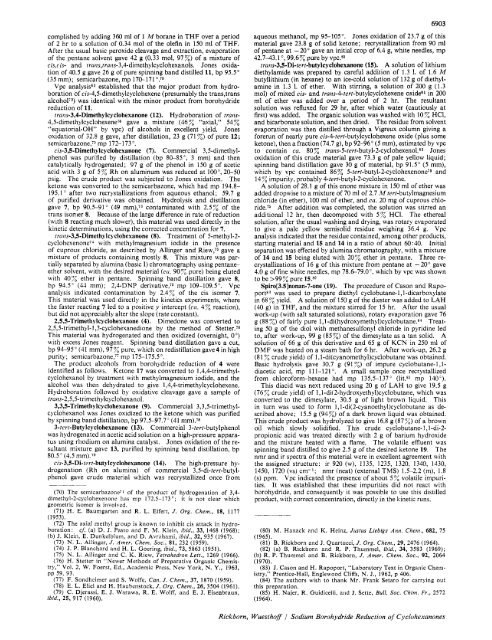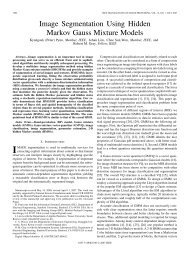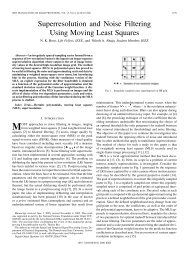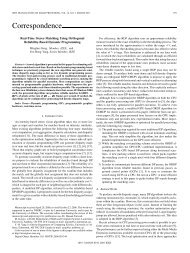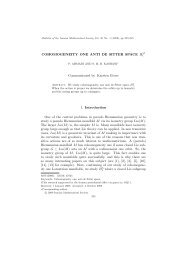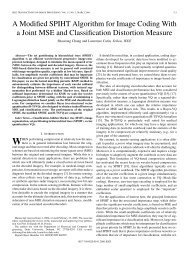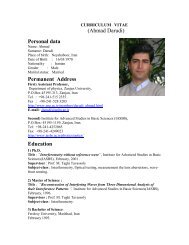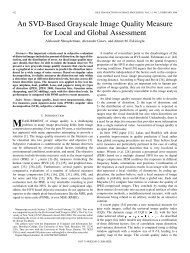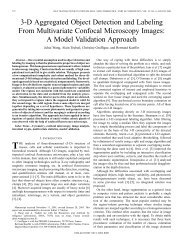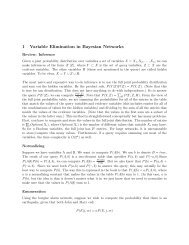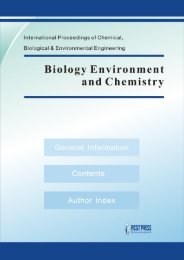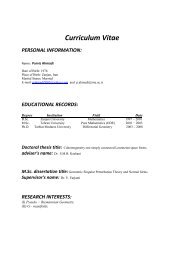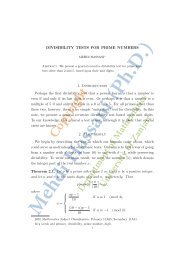1c.pdf
1c.pdf
1c.pdf
You also want an ePaper? Increase the reach of your titles
YUMPU automatically turns print PDFs into web optimized ePapers that Google loves.
complished by adding 360 ml of 1 M borane in THF over a period<br />
of 2 hr to a solution of 0.34 mol of the olefin in 150 ml of THF.<br />
After the usual basic peroxide cleavage and extraction, evaporation<br />
of the pentane solvent gave 42 g (0.33 mol, 97%) of a mixture of<br />
cis,cis- and iraiis,rraiis-3,4-dimethylcyclohexanols. Jones oxidation<br />
of 40.5 g gave 26 g of pure spinning band distilled 11, bp 95.5"<br />
(35 mm); semicarbazone, mp 170-171<br />
Vpc analysis62 established that the major product from hydroboration<br />
of cis-4,5-dimethylcyclohexene (presumably the trans,trans<br />
alcohol?*) was identical with the minor product from borohydride<br />
aqueous methanol, mp 95-105". Jones oxidation of 23.7 g of this<br />
material gave 23.8 g of solid ketone; recrystallization from 90 ml<br />
of pentane at -20" gave an initial crop of 6.4 g, white needles, mp<br />
42.7-43.1 ', 99.6% pure by vpc.SO<br />
trans-3,5-Di-rert-butylcyclohexanone (15). A solution of lithium<br />
diethylamide was prepared by careful addition of 1.3 1. of 1.6 M<br />
butyllithium (in hexane) to an ice-cold solution of 132 g of diethylamine<br />
in 1.3 1. of ether. With stirring, a solution of 200 g (1.3<br />
mol) of mixed cis- and trans-4-terr-butylcyclohexene oxides1 in 200<br />
ml of ether was added over a period of 2 hr. The resultant<br />
reduction of 11.<br />
solution was refluxed for 29 hr, after which water (cautiously at<br />
ira~is-3,4-Dimethylcyclohexanone (12). Hydroboration of tram-<br />
4,5-dimethylcyclohexene3~ gave a mixture (46 % "axial," 54 %<br />
"equatorial-OH" by vpc) of alcohols in excellent yield. Jones<br />
oxidation of 32.8 g gave, after distillation, 23 g (71 %) of pure 12;<br />
semicarbazone,iO mp 172-173 '.<br />
cis-3,5-Dimethylcyclohexanone (7). Commercial 3,5-dimethylfirst)<br />
was added. The organic solution was washed with 10% HCI,<br />
and bicarbonate solution, and then dried. The residue from solvent<br />
evaporation was then distilled through a Vigreux column giving a<br />
forerun of nearly pure cis-4-tert-butylcyclohexene oxide (plus some<br />
ketone), then a fraction (74.7 g), bp 92-96" (5 mm), estimated by vpc<br />
to contain ca. 80% tra~~s-5-rert-butyl-2-cyclohexenol.~~ Jones<br />
phenol was purified by distillation (bp 80-85", 3 mm) and then oxidation of this crude material gave 73.3 g of pale yellow liquid;<br />
catalytically hydrogenated; 97 g of the phenol in 150 g of acetic<br />
acid with 3 g of 5% Rh on aluminum was reduced at loo", 20-50<br />
psig. The crude product was subjected to Jones oxidation. The<br />
spinning band distillation gave 30 g of material, bp 91.5" (5 mm),<br />
which by vpc contained 86 5-tert-butyl-2-cyclohexenone79 and<br />
14 % impurity, probably 4-rert-butyl-2-cyclohexenone.<br />
ketone was converted to the semicarbazone, which had mp 194.8-<br />
195.1 after two recrystallizations from aqueous ethanol; 59.7 g<br />
of purified derivative was obtained. Hydrolysis and distillation<br />
A solution of 28.1 g of this enone mixture in 150 ml of ether was<br />
added dropwise to a mixture of 70 ml of 2.7 M terr-butylmagnesium<br />
chloride (in ether), 100 ml of ether, and ca. 20 mg of cuprous chlogave<br />
7, bp 90.5-91" (49 1nm),7~ contaminated with 2.5% of the<br />
trans isomer 8. Because of the large difference in rate of reduction<br />
ride.75 After addition was completed, the solution was stirred an<br />
additional 12 hr, then decomposed with 5% HCI. The ethereal<br />
(with 8 reacting much slower), this material was used directly in the solution, after the usual washing and drying, was rotary evaporated<br />
kinetic determinations, using the corrected concentration for 7.<br />
rroiw-3,5-Dimethylcyclohexanone (8). Treatment of 5-methyl-2to<br />
give a pale yellow semisolid residue weighing 36.4 g. Vpc<br />
analysis indicated that the residue contained, among other products,<br />
~yclohexenone7~ with methylmagnesium iodide in the presence starting material and 15 and 14 in a ratio of about 60:40. Initial<br />
of cuprous chloride, as described by Allinger and Riew,js gave a<br />
mixture of products containing mostly 8. This mixture was partially<br />
separated by alumina (basic I) chromatography using pentaneseparation<br />
was effected by alumina chromatography, with a mixture<br />
of 14 and 15 being eluted with 20% ether in pentane. Three recrystallizations<br />
of 16 g of this mixture from pentane at -20" gave<br />
ether solvent, with the desired material (cu. 90% pure) being eluted 4.0 g of fine white needles, mp 78.6-79.0'. which by vpc was shown<br />
with 40% ether in pentane. Spinning band distillation gave 8,<br />
bp 94.5" (44 mm); 2,4-DNP deri~ative,'~ mp 109-109.5". Vpc<br />
analysis indicated contamination by 2.4% of the cis isomer 7.<br />
This material was used directly in the kinetics experiments, where<br />
to be >99% pure 15.80<br />
Spiro[3.5]nonan-7-one (19). The procedure of Cason and Rapoports3<br />
was used to prepare diethyl cyclobutane-1,l-dicarboxylate<br />
in 68 % yield. A solution of 150 g of the diester was added to LAH<br />
the faster reacting 7 led to a positive y intercept (ea. 4% reaction), (40 g) in THF, and the mixture stirred for 15 hr. After the usual<br />
but did not appreciably alter the slope (rate constant).<br />
2,5,5-Trimethylcyclohexanone (4). Dimedone was converted to<br />
2,5,5-trimethyl-1,3-cyclohexanedione by the method of Stetter.76<br />
work-up (with salt saturated solutions), rotary evaporation gave 76<br />
g (88 %) of fairly pure l,l-di(hydroxymethyl)cyclobutane.84 Treating<br />
50 g of the diol with methanesulfonyl chloride in pyridine led<br />
This material was hydrogenated and then oxidized (overnight, 0 ")<br />
with excess Jones reagent. Spinning band distillation gave a cut,<br />
bp 94-95" (41 mmj, 97% pure, which on redistillation gave4 in high<br />
purity; semicarbazone,ii mp 175-175.5".<br />
The product alcohols from borohydride reduction of 4 were<br />
identified as follows. Ketone 17 was converted to 1,4,4-trimethylcyclohexanol<br />
by treatment with methylmagnesium iodide, and the<br />
alcohol was then dehydrated to give 1,4,4-trimethylcyclohexene.<br />
Hydroboration followed by oxidative cleavage gave a sample of<br />
tru~is-2,5,5-trimethylcycloliexanol.<br />
3,3,5-Trirnetliylcyclohexanone (9). Commercial 3,3,5-trimethylcyclohexanol<br />
was Jones oxidized to the ketone which was purified<br />
by spinning band distillation, bp 97.5-97.7" (41 mm).i8<br />
3-ter/-Butylcyclohexanone (13). Commercial 3-fert-butylphenol<br />
was hydrogenated in acetic acid solution on a high-pressure apparatus<br />
using rhodium on alumina catalyst. Jones oxidation of the resultant<br />
mixture gave 13, purified by spinning band distillation, bp<br />
80.5'(4.5<br />
cis-3,5-Di-tert-butylcyclohexanone (14). The high-pressure hydrogenation<br />
(Rh on alumina) of commercial 3,5-di-rert-butylphenol<br />
gave crude material which was recrystallized once from<br />
to, after work-up, 99 g (85%) of the dimesylate as a tan solid. A<br />
solution of 66 g of this derivative and 65 g of KCN in 250 ml of<br />
DMF was heated on a steam bath for 6 hr. After work-up, 26.2 g<br />
(8 1 % crude yield) of I ,1-di(cyanomethy1)cyclobutane was obtained.<br />
Basic hydrolysis gave 30.7 g (91 %) of impure cyclobutane-1,ldiacetic<br />
acid, mp 11 1-121 '. A small sample once recrystallized<br />
from chloroform-hexane had mp 135.5-137" (Mar mp 140').<br />
This diacid was next reduced using 20 g of LAH to give 19.5 g<br />
(76% crude yield) of l,l-di~2-hydroxyethyI)cyclobutane, which was<br />
converted to the dimesylate, 30.5 g of light brown liquid. This<br />
in turn was used to form l,l-di(2-cyanoethyl)cyclobutane as described<br />
above; 15.5 g (94%) of a dark brown liquid was obtained.<br />
This crude product was hydrolyzed to give 16.8 g (87%) of a brown<br />
oil which slowly solidified. This crude cyclobutane-l,l-di-2propionic<br />
acid was treated directly with 2 g of barium hydroxide<br />
and the mixture heated with a flame. The volatile emuent was<br />
spinning band distilled to give 2.5 g of the desired ketone 19. The<br />
nmr and ir spectra of this material were in excellent agreement with<br />
the assigned structure: ir 920 (w), 1135, 1235, 1320. 1340, 1430,<br />
14.50, 1720 (vs) ern-'; nmr (neat) (external TMS) 1.5-2.2 (m), 1.8<br />
(s) ppm. Vpc indicated the presence of about 5% volatile impurities.<br />
It was established that these impurities did not react with<br />
(70) The semicarbazone71 of the product of hydrogenation of 3,4dimethyl-2-cyclohexenone<br />
has mp 172.5-173"; it is not clear which<br />
geometric isomer is involved.<br />
(71) H. E. Baumgarten and R. L. Eifert, J. Org. Chem., 18, 1177<br />
( 1953).<br />
(72) The axial methyl group is known to inhibit cis attack in hydroboration:<br />
cf. (a) D. J. Pasto and F. M. Klein, ibid., 33, 1468 (1968);<br />
(b) J. Klein, E. Dunkelblum, and D. Avrahami, ibid., 32, 935 (1967).<br />
(73) N. L. Allinger, J. Amer. Chem. SOC., 81, 232 (1959).<br />
(74) J. P. Blanchard and H. L. Goering, ibid., 73, 5863 (1951).<br />
(75) N. L. Allinger and C. K. Riew, Terrahedron Lett., 1269 (1966).<br />
(76) H. Stetter in "Newer Methods of Preparative Organic Chemistry,"<br />
Vol. 2, W. Foerst, Ed., Academic Press, New York, N. Y., 1963,<br />
pp 59, 93.<br />
(77) F. Sondhrimer and S. Wolfe, Can. J. Chem., 37, 1870 (1959).<br />
(78) E. L. Eliel and H. Haubenstock, J. Org. Chem., 26,3504 (1961).<br />
(79) C. Djerassi, E. J. Warawa, R. E. Wolff, and E. J. Eisenbraun,<br />
ibid., 25, 917 (1960).<br />
borohydride, and consequently it was possible to use this distilled<br />
product, with correct concentration, directly in the kinetic runs.<br />
(80) M. Hanack and I


